


Divalent chromium - sensitivity for oxidation
The most stable oxidation state of chromium is +3. In this oxidation state, the metal is not easily oxidized, not is it easily reduced. It is possible, however, to create chromium in its +2 oxidation state. This can be achieved by dissolving the metal in hydrochloric acid with exclusion of air. In this experiment it is shown how sensitive chromium in its +2 oxidation state is to aerial oxidation. The divalent chromium ion really sucks oxygen from the air and is very easily converted to chromium (III). This experiment also shows that it will be very hard to obtain a pure chromium (II) compound and to store such compounds.
![]()
![]() Required
chemicals:
Required
chemicals:
-
chromium metal of high purity
-
concentrated hydrochloric acid
![]() Required
equipment:
Required
equipment:
-
test tubes
-
burner for heating the test tubes
![]() Safety:
Safety:
- hydrochloric acid is corrosive, the concentrated acid gives off fumes, which are very noxious.
![]() Disposal:
Disposal:
- The waste can be flushed down the drain with a lot of water. Chromium (III) ions are only moderately toxic for the environment and the amount of metal used is only in the mg range.
![]()
Procedure for performing the experiment
![]() Put a
'flake' of high purity chromium in a test tube. A few tens of mg of metal is more
than sufficient. Using too much results in concentrated solutions, which are
very dark and make observations more difficult.
Put a
'flake' of high purity chromium in a test tube. A few tens of mg of metal is more
than sufficient. Using too much results in concentrated solutions, which are
very dark and make observations more difficult.
![]() Pour
approximately 2 ml of concentrated hydrochloric acid in the test tube. The
result of this is that a colorless gas is evolved at the metal at a very low
rate. This gas is hydrogen.
Pour
approximately 2 ml of concentrated hydrochloric acid in the test tube. The
result of this is that a colorless gas is evolved at the metal at a very low
rate. This gas is hydrogen.
![]() Loosely
stopper the test tube, such that evolved gas can escape easily, but such that
there is no free path for air to enter the test tube. A loosely plugged cork or
some cotton-wool at the open end of the test tube is OK.
Loosely
stopper the test tube, such that evolved gas can escape easily, but such that
there is no free path for air to enter the test tube. A loosely plugged cork or
some cotton-wool at the open end of the test tube is OK.
![]() Heat the
liquid somewhat, such that the evolution of gas is faster. Now you can see that
the liquid becomes green, due to formation of chromium (III) ions. After a
while, however, more metal dissolves, but remarkably, the liquid becomes lighter
and the color shifts to blue. The chromium (III), already present, is reduced to
chromium (II) again and further metal also is converted to chromium (II). The bubbles
consist of hydrogen gas. The initial green color is due to the initial amount of
oxygen in the test tube and oxygen dissolved in the acid. Later on, when all
oxygen in the test tube is used up, the liquid remains blue.
Heat the
liquid somewhat, such that the evolution of gas is faster. Now you can see that
the liquid becomes green, due to formation of chromium (III) ions. After a
while, however, more metal dissolves, but remarkably, the liquid becomes lighter
and the color shifts to blue. The chromium (III), already present, is reduced to
chromium (II) again and further metal also is converted to chromium (II). The bubbles
consist of hydrogen gas. The initial green color is due to the initial amount of
oxygen in the test tube and oxygen dissolved in the acid. Later on, when all
oxygen in the test tube is used up, the liquid remains blue.
The three pictures below show:
- the sample of chromium used in this experiment;
- the initial stage of vigorous bubbling, just after heating the contents of the test tube and still with quite some chromium (III) in the test tube;
- the formation of chromium (II) ions, which are lighter than chromium (III) ions and which are blue.
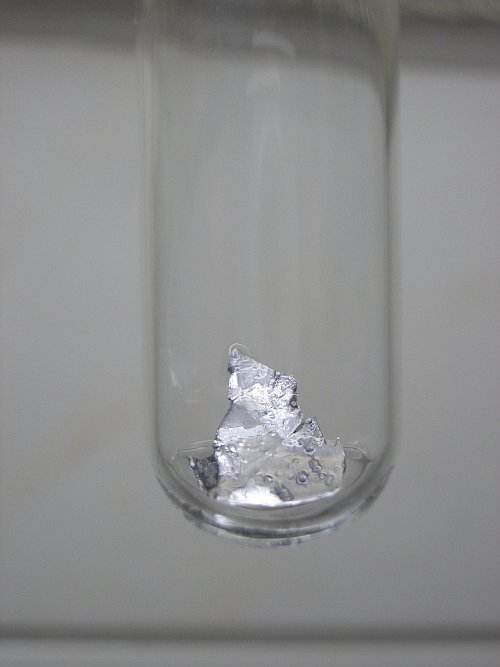
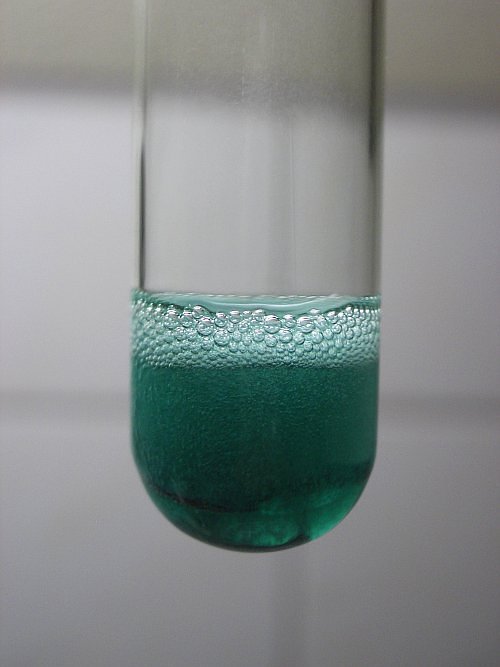
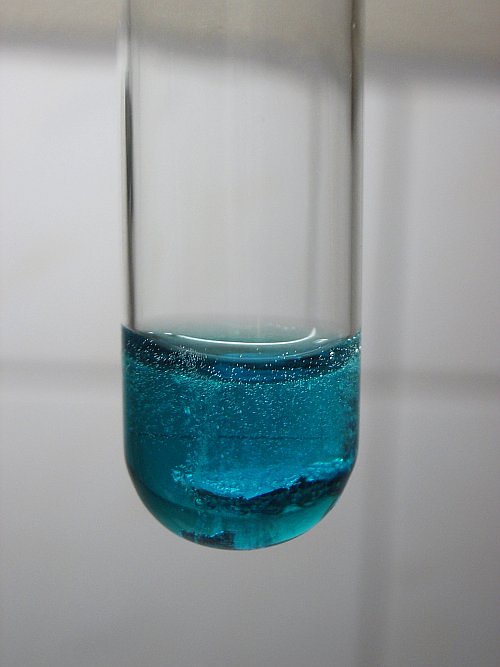
![]() At a
certain point, dilute the acid, containing the blue chromium (II) with a fairly
large amount of water, which was boiled first for a while, in order to drive off
oxygen from the water. This results in a blue liquid. At the surface of the
liquid, the liquid becomes green very quickly. It absorbs oxygen from the air
really quickly!
At a
certain point, dilute the acid, containing the blue chromium (II) with a fairly
large amount of water, which was boiled first for a while, in order to drive off
oxygen from the water. This results in a blue liquid. At the surface of the
liquid, the liquid becomes green very quickly. It absorbs oxygen from the air
really quickly!
The top-left picture shows the test tube with the diluted chromium (II), immediately after the water is added. At the top, a thin layer of a greenish liquid can be observed.
The top-right picture shows that the green layer is a little thicker and more vague. Mixing of the liquid goes quite fast, because of the fact that the piece of metallic chromium still slowly dissolves and bubbles of hydrogen are formed.
In the third picture (bottom-left) it is shown, what happens to the liquid, when the test tube is kept almost horizontal and then back to vertical, allowing a large surface area to contact the air. The liquid has become really dark. Only at the bottom-right of the test tube some of the lighter blue color can be observed.
The last picture (bottom-right) finally shows the liquid with all chromium (II) oxidized to chromium (III). This is very dark green.
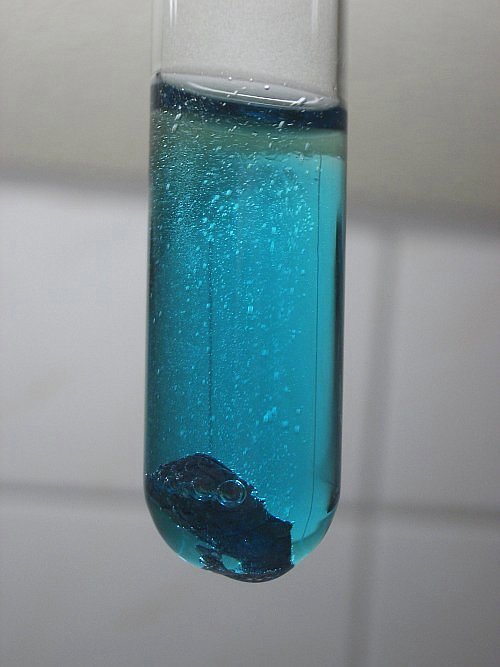
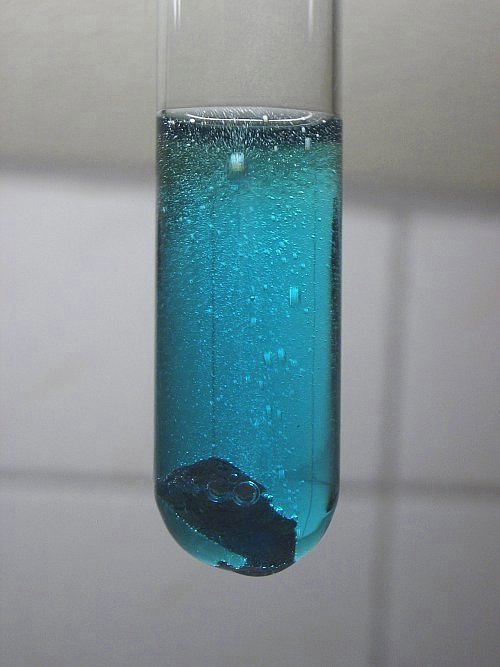
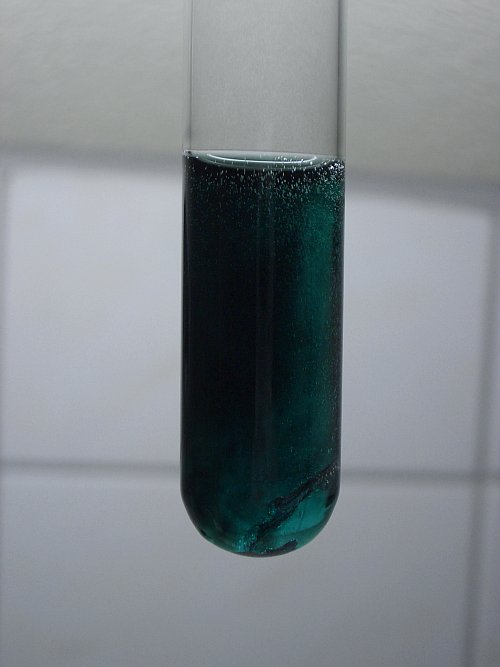
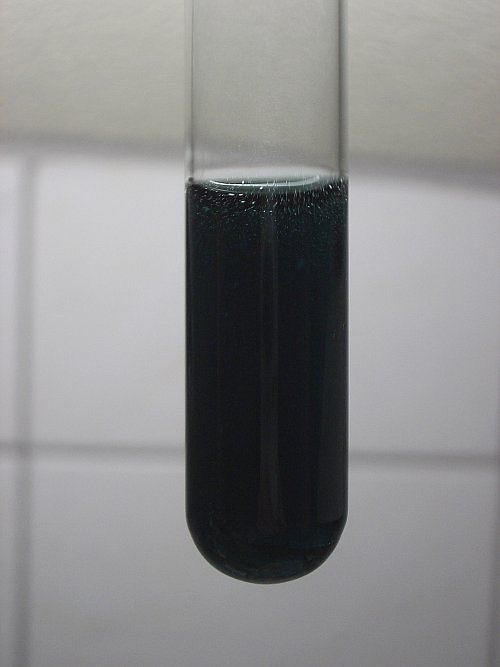
The final color is shown in the larger picture below. In order to make this picture, a small part of the dark green liquid is taken and this is diluted approximately 5 times with water. This results in a still fairly dark green liquid.
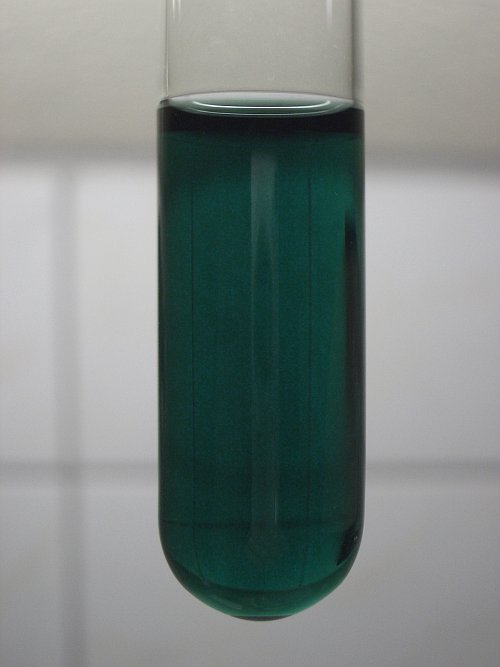
![]()
Discussion of results
![]() Chromium
metal reacts with acid as follows:
Chromium
metal reacts with acid as follows:
Cr(s) + 2H+(aq) → Cr2+(aq) + H2(g)
With some oxygen from the air and oxygen, dissolved in the acid, initially this blue chromium (II) ion is converted to dark green chromium (III).
4Cr2+(aq) + O2(aq,g) + 4H+(aq) → 4Cr3+(aq) + 2H2O
Later on, when more chromium metal dissolves, then the liquid becomes blue again. The chromium (III) is reduced to chromium (II) by metallic chromium and/or by nascent hydrogen, produced by the dissolving metal. The nascent hydrogen is produced at the surface of the metal and is more reactive, before it is turned in gaseous hydrogen.
2Cr3+(aq) + Cr(s) → 3Cr2+(aq)
2Cr3+(aq) + H2(nasc) → 2Cr2+(aq) + 2H+(aq)
![]() When
oxygen is allowed to enter the reaction mixture, then the chromium (II) is
oxidized to chromium (III).
When
oxygen is allowed to enter the reaction mixture, then the chromium (II) is
oxidized to chromium (III).
4Cr2+(aq) + O2(aq,g) + 4H+(aq) → 4Cr3+(aq) + 2H2O
The chromium (III) ions are coordinated to chloride ions, as soon as they are formed. This causes the green color.
![]()
In fact, the production of many chromium (III) complexes is done by means of oxidation of a chromium (II) compound in a suitable coordinating environment. Chromium (III) complexes are very inert, meaning that once a ligand is attached to the chromium (III) core, it is only disconnected with difficulty. A very nice example of this is the formation of the Cr(NH3)63+ complex. This complex hardly can be made by adding ammonia to a solution of a chromium (III) salt. It can however, easily be made, by adding ammonia to a solution of a chromium (II) salt and then bringing the liquid in contact with air. On formation of the chromium (III) ion, it immediately 'seeks' ligands and then it selects the most favorable ones. Once the ligands are attached, the complex is very stable.